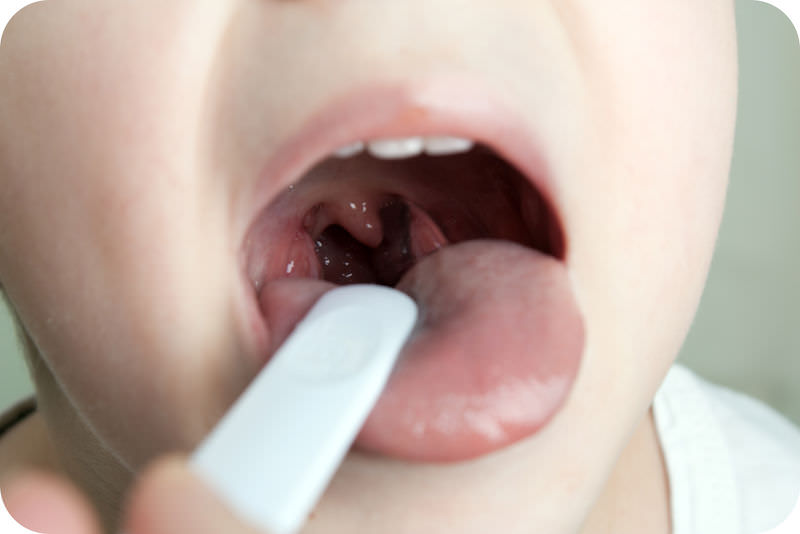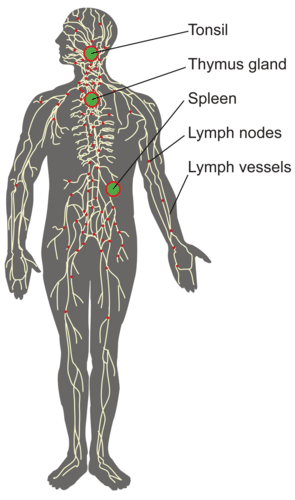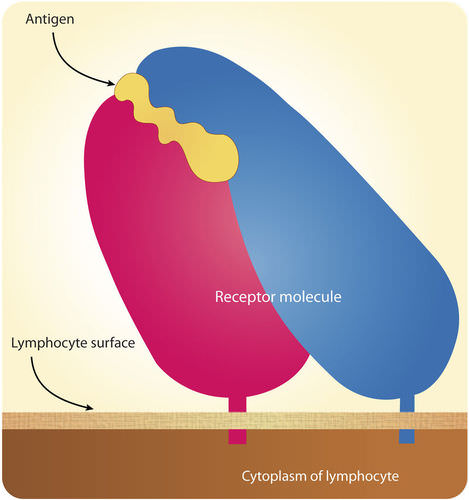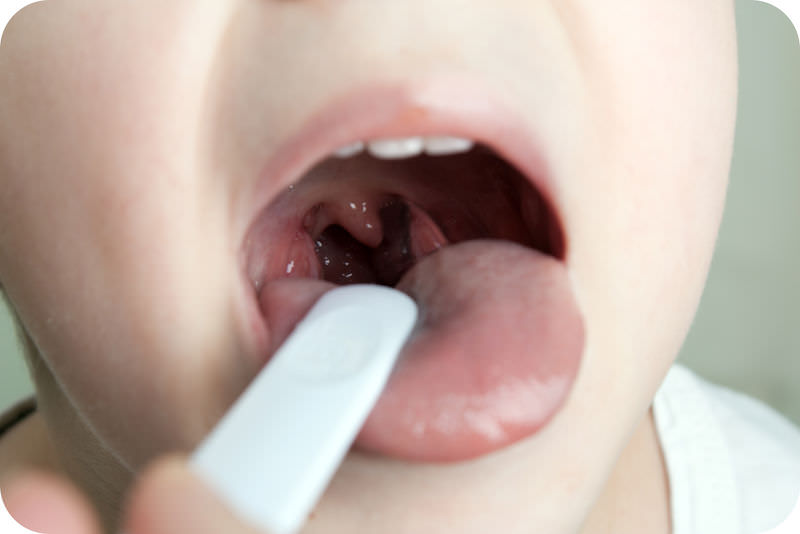13.41: Lymphatic System
- Page ID
- 13317
\( \newcommand{\vecs}[1]{\overset { \scriptstyle \rightharpoonup} {\mathbf{#1}} } \)
\( \newcommand{\vecd}[1]{\overset{-\!-\!\rightharpoonup}{\vphantom{a}\smash {#1}}} \)
\( \newcommand{\dsum}{\displaystyle\sum\limits} \)
\( \newcommand{\dint}{\displaystyle\int\limits} \)
\( \newcommand{\dlim}{\displaystyle\lim\limits} \)
\( \newcommand{\id}{\mathrm{id}}\) \( \newcommand{\Span}{\mathrm{span}}\)
( \newcommand{\kernel}{\mathrm{null}\,}\) \( \newcommand{\range}{\mathrm{range}\,}\)
\( \newcommand{\RealPart}{\mathrm{Re}}\) \( \newcommand{\ImaginaryPart}{\mathrm{Im}}\)
\( \newcommand{\Argument}{\mathrm{Arg}}\) \( \newcommand{\norm}[1]{\| #1 \|}\)
\( \newcommand{\inner}[2]{\langle #1, #2 \rangle}\)
\( \newcommand{\Span}{\mathrm{span}}\)
\( \newcommand{\id}{\mathrm{id}}\)
\( \newcommand{\Span}{\mathrm{span}}\)
\( \newcommand{\kernel}{\mathrm{null}\,}\)
\( \newcommand{\range}{\mathrm{range}\,}\)
\( \newcommand{\RealPart}{\mathrm{Re}}\)
\( \newcommand{\ImaginaryPart}{\mathrm{Im}}\)
\( \newcommand{\Argument}{\mathrm{Arg}}\)
\( \newcommand{\norm}[1]{\| #1 \|}\)
\( \newcommand{\inner}[2]{\langle #1, #2 \rangle}\)
\( \newcommand{\Span}{\mathrm{span}}\) \( \newcommand{\AA}{\unicode[.8,0]{x212B}}\)
\( \newcommand{\vectorA}[1]{\vec{#1}} % arrow\)
\( \newcommand{\vectorAt}[1]{\vec{\text{#1}}} % arrow\)
\( \newcommand{\vectorB}[1]{\overset { \scriptstyle \rightharpoonup} {\mathbf{#1}} } \)
\( \newcommand{\vectorC}[1]{\textbf{#1}} \)
\( \newcommand{\vectorD}[1]{\overrightarrow{#1}} \)
\( \newcommand{\vectorDt}[1]{\overrightarrow{\text{#1}}} \)
\( \newcommand{\vectE}[1]{\overset{-\!-\!\rightharpoonup}{\vphantom{a}\smash{\mathbf {#1}}}} \)
\( \newcommand{\vecs}[1]{\overset { \scriptstyle \rightharpoonup} {\mathbf{#1}} } \)
\( \newcommand{\vecd}[1]{\overset{-\!-\!\rightharpoonup}{\vphantom{a}\smash {#1}}} \)
\(\newcommand{\avec}{\mathbf a}\) \(\newcommand{\bvec}{\mathbf b}\) \(\newcommand{\cvec}{\mathbf c}\) \(\newcommand{\dvec}{\mathbf d}\) \(\newcommand{\dtil}{\widetilde{\mathbf d}}\) \(\newcommand{\evec}{\mathbf e}\) \(\newcommand{\fvec}{\mathbf f}\) \(\newcommand{\nvec}{\mathbf n}\) \(\newcommand{\pvec}{\mathbf p}\) \(\newcommand{\qvec}{\mathbf q}\) \(\newcommand{\svec}{\mathbf s}\) \(\newcommand{\tvec}{\mathbf t}\) \(\newcommand{\uvec}{\mathbf u}\) \(\newcommand{\vvec}{\mathbf v}\) \(\newcommand{\wvec}{\mathbf w}\) \(\newcommand{\xvec}{\mathbf x}\) \(\newcommand{\yvec}{\mathbf y}\) \(\newcommand{\zvec}{\mathbf z}\) \(\newcommand{\rvec}{\mathbf r}\) \(\newcommand{\mvec}{\mathbf m}\) \(\newcommand{\zerovec}{\mathbf 0}\) \(\newcommand{\onevec}{\mathbf 1}\) \(\newcommand{\real}{\mathbb R}\) \(\newcommand{\twovec}[2]{\left[\begin{array}{r}#1 \\ #2 \end{array}\right]}\) \(\newcommand{\ctwovec}[2]{\left[\begin{array}{c}#1 \\ #2 \end{array}\right]}\) \(\newcommand{\threevec}[3]{\left[\begin{array}{r}#1 \\ #2 \\ #3 \end{array}\right]}\) \(\newcommand{\cthreevec}[3]{\left[\begin{array}{c}#1 \\ #2 \\ #3 \end{array}\right]}\) \(\newcommand{\fourvec}[4]{\left[\begin{array}{r}#1 \\ #2 \\ #3 \\ #4 \end{array}\right]}\) \(\newcommand{\cfourvec}[4]{\left[\begin{array}{c}#1 \\ #2 \\ #3 \\ #4 \end{array}\right]}\) \(\newcommand{\fivevec}[5]{\left[\begin{array}{r}#1 \\ #2 \\ #3 \\ #4 \\ #5 \\ \end{array}\right]}\) \(\newcommand{\cfivevec}[5]{\left[\begin{array}{c}#1 \\ #2 \\ #3 \\ #4 \\ #5 \\ \end{array}\right]}\) \(\newcommand{\mattwo}[4]{\left[\begin{array}{rr}#1 \amp #2 \\ #3 \amp #4 \\ \end{array}\right]}\) \(\newcommand{\laspan}[1]{\text{Span}\{#1\}}\) \(\newcommand{\bcal}{\cal B}\) \(\newcommand{\ccal}{\cal C}\) \(\newcommand{\scal}{\cal S}\) \(\newcommand{\wcal}{\cal W}\) \(\newcommand{\ecal}{\cal E}\) \(\newcommand{\coords}[2]{\left\{#1\right\}_{#2}}\) \(\newcommand{\gray}[1]{\color{gray}{#1}}\) \(\newcommand{\lgray}[1]{\color{lightgray}{#1}}\) \(\newcommand{\rank}{\operatorname{rank}}\) \(\newcommand{\row}{\text{Row}}\) \(\newcommand{\col}{\text{Col}}\) \(\renewcommand{\row}{\text{Row}}\) \(\newcommand{\nul}{\text{Nul}}\) \(\newcommand{\var}{\text{Var}}\) \(\newcommand{\corr}{\text{corr}}\) \(\newcommand{\len}[1]{\left|#1\right|}\) \(\newcommand{\bbar}{\overline{\bvec}}\) \(\newcommand{\bhat}{\widehat{\bvec}}\) \(\newcommand{\bperp}{\bvec^\perp}\) \(\newcommand{\xhat}{\widehat{\xvec}}\) \(\newcommand{\vhat}{\widehat{\vvec}}\) \(\newcommand{\uhat}{\widehat{\uvec}}\) \(\newcommand{\what}{\widehat{\wvec}}\) \(\newcommand{\Sighat}{\widehat{\Sigma}}\) \(\newcommand{\lt}{<}\) \(\newcommand{\gt}{>}\) \(\newcommand{\amp}{&}\) \(\definecolor{fillinmathshade}{gray}{0.9}\)
What happens when your tonsils cause more problems than they solve?
Almost all of us have had a sore throat at some time. Maybe you had your tonsils out when you were younger? Why? Your tonsils are two lumps of tissue that work as germ fighters for your body. But sometimes germs like to hang out there, where they cause infections. In other words, your tonsils can cause more problems than they solve. So, you have them taken out.
Lymphatic System
Like the immune systems of other vertebrates, the human immune system is adaptive. If pathogens manage to get through the body’s first two lines of defense, the third line of defense takes over. The third line of defense is referred to as the immune response. This defense is specific to a particular pathogen, and it allows the immune system to “remember” the pathogen after the infection is over. If the pathogen tries to invade the body again, the immune response against that pathogen will be much faster and stronger.
The immune response mainly involves the lymphatic system. The lymphatic system is a major part of the immune system. It produces leukocytes called lymphocytes. Lymphocytes are the key cells involved in the immune response. They recognize and help destroy particular pathogens in body fluids and cells. They also destroy certain cancer cells.
Structures of the Lymphatic System
Figure below shows the structures of the lymphatic system. They include organs, lymph vessels, lymph, and lymph nodes. Organs of the lymphatic system are the bone marrow, thymus, spleen, and tonsils.
- Bone marrow is found inside many bones. It produces lymphocytes.
- The thymus is located in the upper chest behind the breast bone. It stores and matures lymphocytes.
- The spleen is in the upper abdomen. It filters pathogens and worn out red blood cells from the blood, and then lymphocytes in the spleen destroy them.
- The tonsils are located on either side of the pharynx in the throat. They trap pathogens, which are destroyed by lymphocytes in the tonsils.
 The lymphatic system consists of organs, vessels, and lymph.
The lymphatic system consists of organs, vessels, and lymph.Lymphatic Vessels and Lymph
Lymphatic vessels make up a body-wide circulatory system. The fluid they circulate is lymph. Lymph is a fluid that leaks out of capillaries into spaces between cells. As the lymph accumulates between cells, it diffuses into tiny lymphatic vessels. The lymph then moves through the lymphatic system from smaller to larger vessels. It finally drains back into the bloodstream in the chest. As lymph passes through the lymphatic vessels, pathogens are filtered out at small structures called lymph nodes (see Figure above). The filtered pathogens are destroyed by lymphocytes.
Lymphocytes
The human body has as many as two trillion lymphocytes, and lymphocytes make up about 25% of all leukocytes. The majority of lymphocytes are found in the lymphatic system, where they are most likely to encounter pathogens. The rest are found in the blood. There are two major types of lymphocytes, called B cells and T cells. These cells get their names from the organs in which they mature. B cells mature in bone marrow, and T cells mature in the thymus. Both B and T cells recognize and respond to particular pathogens.
Antigen Recognition
B cells and T cells actually recognize and respond to antigens on pathogens. Antigens are molecules that the immune system recognizes as foreign to the body. Antigens are also found on cancer cells and the cells of transplanted organs. They trigger the immune system to react against the cells that carry them. This is why a transplanted organ may be rejected by the recipient’s immune system.
How do B and T cells recognize specific antigens? They have receptor molecules on their surface that bind only with particular antigens.
As shown in Figure below, the fit between an antigen and a matching receptor molecule is like a key in a lock.
 An antigen fits the matching receptor molecule like a key in a lock.
An antigen fits the matching receptor molecule like a key in a lock.Summary
- The body’s third line of defense is the immune response. This involves the lymphatic system. This system filters pathogens from lymph and produces lymphocytes.
- Lymphocytes are the key cells in the immune response. They are leukocytes that become activated by a particular antigen. There are two major type of lymphocytes: B cells and T cells.
Review
- What is the lymphatic system?
- List three organs of the lymphatic system and their functions.
- What are lymph nodes? What is their function?
- What are the two major types of lymphocytes?
- What are antigens, and how do lymphocytes “recognize” them?
| Image | Reference | Attributions |
 |
[Figure 1] | Credit: Hana Zavadska Source: CK-12 Foundation License: CC BY-NC 3.0 |
 |
[Figure 2] | Credit: Mariana Ruiz Villarreal (LadyofHats) for CK-12 Foundation Source: CK-12 Foundation License: CC BY-NC 3.0 |
 |
[Figure 3] | Credit: Hana Zavadska Source: CK-12 Foundation License: CC BY-NC 3.0 |

